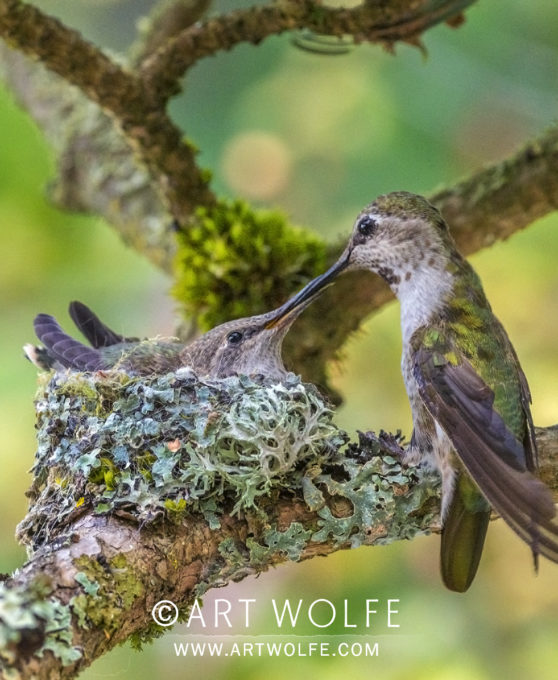Technique Tuesday: Capturing Wildlife in the Moment
This excerpt is from “Photographs from the Edge”, which not only details the stories behind some of my most well-known captures from across the globe and throughout my career, but is also filled with tips and tricks and equipment information.
 July 2014: Rufous Hummingbird and Chick, Seattle, Washington, USA
July 2014: Rufous Hummingbird and Chick, Seattle, Washington, USA
Canon EOS-1D X, EF 200-400mm f/4L IS USM EXT lens +1.4x, ƒ/20 for 1/125 sec., ISO 4000
The nature of the photo: All hummingbirds are remarkable birds for their amazing flight abilities. However, the rufous hummingbird, a bird about three-inches long and weighing about a tenth of an ounce, has the longest migration of any U.S. bird its size. It may go the distance from Alaska to well into Mexico, and some scientists think it may go as far as Panama.
I have spent 30 years developing and cultivating a Japanese-inspired garden around my house in Seattle. It has filled in nicely, creating a wild space by my home. I planted some black pines in my garden early on to provide year-round structure and color, besides refuge for birds and other wildlife. I have steadily shaped and pruned them bonsai style to help them fit into the space of my garden.
In 2014 as I was working on my trees, I found a bird staring me in the face. As I looked down past the bird, there was the nest. A rufous female hummingbird had chosen to nest in my beloved black pines! That sort of discovery still excites me after so many years connecting with nature.
A hummingbird nest is so tiny, no more than 2 inches across. The bird covers her nest with lichen, so it is easy to miss in the lichen-covered black pine. But luck had been with me, so I quickly descended from my stepladder and forgot about pruning the trees that day.
I wanted to photograph the mother as it raised its young, so I set up my camera about 10 feet away from the nest. Even that close, hummingbirds are really small, so I needed to use a 200-400mm lens at 400mm plus a 1.4x converter. I could then take pictures from the lawn chair without being so close to the nest as to disturb the mother. I had a field day for the next two weeks as this hummingbird raised its young.
Photo tip: Wildlife photography is rarely about just capturing the animal in a photograph. Timing can be critical to getting the remarkable, striking shot. You have to keep shooting, always paying attention, to be sure you do get that shot. Shooting your camera continuously will not necessarily get the shot, though, because the key moment may be between frames.


Nice shot, So are you saying you don’t shoot continuously when shooting something like an eagle in flight ? If not what do you do ? Just got back from an Alaskan Cruise and they played a lot of your videos on our tv in the cabin, it was great to watch. Really like your work, Thanks for sharing !!
It still makes sense to me to shoot continuously. The more frames per second the better. Even though the great moment may occur between frames, that still seems to give the best chance for success, in my opinion. That being said, watching and anticipating before starting my continuous stream of shots is important so I give myself the best chance to be shooting while a great moment occurs. If Art and his team go about it differently, that would be interesting to know. Happy shooting.
Hi Art. Beautiful photograph. I try to capture behaviour as much as the beauty each animal gives us. As I learn to photograph nature, I have also learned the virtue of patience and persistence. I am also inspired by your photographs a the stories behind thm . Thank you for sharing both.
* Great shot! And a perfect moment, particularly if you are shooting hummingbirds because they constantly keep moving.
* I noticed that you have ƒ/20 & ISO 4000 for this shot. You don’t need a great DOF for this kind of shot but you still choose f/20, why? Also, why did you choose ISO 4000? I would have tried with a f/5.6 ~ f/8 & ISO of 100 ~ 400. Don’t you think a lower “f” number and lower ISO would have given you a better quality picture?
Regards,
Umesh